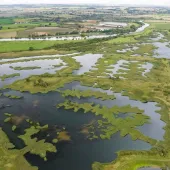Working to realize mineral site potential since 2006

Tenth anniversary of the launch of the landmark RSPB report ‘Nature After Minerals’
THIS month marks the tenth anniversary of the launch of the landmark RSPB report entitled ‘Nature After Minerals: how mineral site restoration can benefit people and wildlife’.
This much-respected publication was the result of an extensive Geographical Information System (GIS) model review of all active mineral sites in England, to assess their potential to deliver against existing Biodiversity Action Plan (BAP) habitat creation targets at the time and thereby protect species.
The report highlighted the immense potential that existed, and still does, for minerals restoration to deliver for nature and people on a grand scale.
Nature After Minerals (NAM) was devised on the back of the findings of this report to help convert this potential into reality through the sharing of best-practice advice, encouragement and the promotion of appropriate and sustainable biodiversity-led minerals restoration.
In the 10 years since the report’s release, much progress has been made, with working and worked-out quarries – managed and restored with nature and people very much in mind – increasingly providing vital refuges across whole landscapes, to help buffer and link existing conservation hotspots, providing corridors for wildlife to move along and places for people to enjoy.
NAM says it was particularly good to see recognition of the impact that wetland habitat creation through minerals restoration is having on species conservation, as highlighted in the recent multi-partnered State of Nature 2016 Report from more than 50 wildlife conservation and research organizations.
Nevertheless, whilst there are success stories to be found, the overriding trend in species decline through habitat loss means there is still much to be done, and NAM is looking forward to continuing to work with minerals restoration stakeholders to help ensure this great potential to give back to nature is realized.









